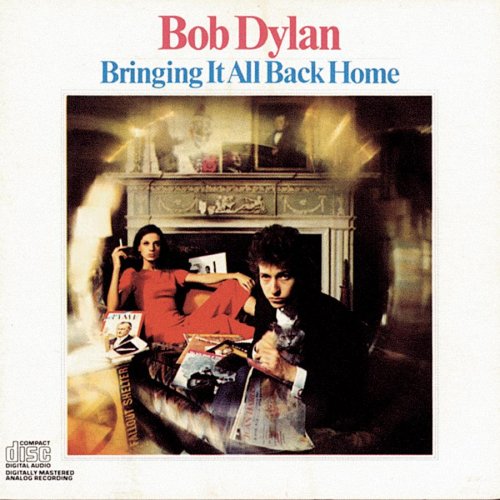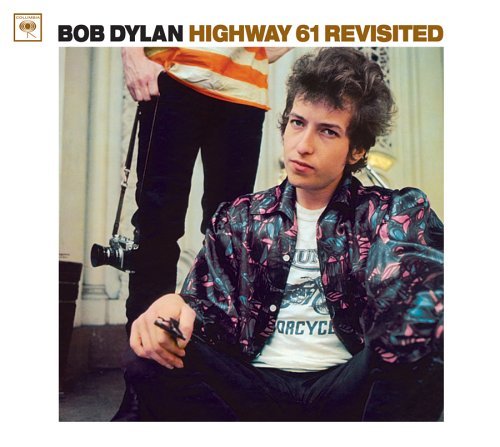
Versus is a series in which we pit selected albums against one another and offer case statements for which is superior. In our latest installment, we isolate three of Bob Dylan’s most acclaimed records and pose the question: which do you think is his best album?
Bringing It All Back Home (1965)

Bringing It All Back Home has Bob Dylan yearning to break free from a society in shambles. Seeking refuge from the repulsive inauthenticity blanketing every aspect of America’s turbulent public sphere, Dylan retreats within the bounds of his autonomous individual consciousness. “The only thing that’s real, “ Dylan declared to protest folkie Phi Ochs just after releasing BIABH, “is inside you. Your feelings.” Dylan’s individualistic revolt, hatched in BIABH, necessitates an escape from the chaotic, decrepit social realm to the sanctuary of one’s own psyche.
In “Mr. Tambourine Man,” Dylan describes a limitless landscape apart from society. To listen to the track is to be seduced into an existence of utter freedom and complete autonomy within oneself. Liberated from society’s obligations and anxieties, Dylan shamelessly requests: “Hey! Mr. Tambourine Man, play a song for me.” All ties to the outside world are gladly relinquished, giving him our undivided attention: “I’m not sleepy and there is no place I’m going to.” Subtle jangly guitar picking captures the outside traces of consciousness, and, as with the pied piper, we follow the minstrel. A new birth, the tabula rasa that accompanies departure from a world no longer offering a meaningful future: “The ancient empty street’s too dead for dreaming.” Imagine all we’ve acquired and achieved falling away like a handful of sand: “With all memory and fate driven deep beneath the waves.” This is a place where we no longer see, hear, smell, taste, or touch—we’re transcendental: “My senses have been stripped/ My hands can’t feel to grip.” The only march is our own parade, and the lure of complete isolation is wholly compelling: “Cast your dancing spell my way/ I promise to go under it.”
We withdraw so deeply within ourselves that we go beyond time and space to reach a Zen drenched unity with our world. Escape from society transports us to a peaceful, mystic realm of bliss. With utopia just a tambourine’s jingle jangle away, Dylan ponders whether a movement to repair society’s ancient empty streets packed with obligation, compromise, and broken dreams is a worthwhile endeavor.
A gentle, solemn tempo begins “It’s All Over Now, Baby Blue” as Dylan lulls himself into a trancelike state. In a raspy monotone, Dylan appears to be delivering a requiem. He urges immediate escape: “You must leave now, take what you need you think will last/ But whatever you wish to keep, you better grab it fast.” Lost in his words, Dylan withdraws to contemplate deeper meaning. The full spectrum of Dylan’s emotions floods a bluesy harmonica, cloaking the track in a cape of conclusively. Everything you have come to rely on now lays in ruins. Dylan sings in a mourning tone as a sense of impeding doom creeps forward, yet the song ends on a hopeful note of individual rebirth and a chance for redemption: “Strike another match, go start anew.”
Featuring neo-Beat incantations “Gates of Eden” and “It’s Alright Ma (I’m Only Bleeding),” smitten love ditty “Love Minus Zero / No Limit,” and whimsical stream of consciousness epic “Bob Dylan’s 115th Dream,” the LP is as diverse as it is deep. And those rambling admonitions on “Subterranean Homesick Blues” – Dylan’s first single to chart in the U.S. – provide at least as much guidance as Poor Richards’ Almanac or the King James Bible.
Since its inception as an art form, a fundamental characteristic of rock music has always been its rebellious nature. The goal of revolt -and true art- must be to effect a change in milieu. The savage, scathing individualism of Dylan’s Bringing It All Back Home launched a groundbreaking vanguard modernist impulse that is starkly distinct from the sexual radicalism of Elvis Presley or socialist populism of Woody Guthrie. In this way, Dylan’s individualistic revolt paved the way for apolitical, introspective revolutionaries from Jefferson Airplane to Devo, and it all started with Bringing It All Back Home.
– Henry Hauser
Highway 61 Revisited (1965)

Has any musician ever had a better year than Bob Dylan did in 1965? This feature is meant to “pit selected albums against one another,” but let’s be honest: when you’re comparing Dylan’s classics, you’re splitting hairs. Bringing It All Back Home, Dylan’s first release of 1965, is a folk music landmark. It is song-for-song one of the best albums recorded not just in the genre’s lineage, but in music history. But even though the margins are razor thin, it isn’t his best release (of the year or his career). And the case for Blood On The Tracks, which would arrive a decade later, is strong too. But nothing tops Highway 61 Revisited.
If forced to distill the album into just one signature moment, you’d be crazy to finger anything other than “Like a Rolling Stone.” If you see Dylan and his band perform it now, you might notice that the song has been re-worked into something altogether different and frustratingly generic. But the fact remains that the original recording is one of the most brilliant pieces of songwriting ever put on paper and set to guitar. This song alone transcends Americana and makes Highway 61 unmistakable and essential. And it’s only the first track on the album.
There isn’t a weak track on the album, to be sure, but what really stands out is how some of the less heralded tracks that comprise Highway 61 may actually sound better than “Like a Rolling Stone.” “Tombstone Blues” is a long-time favorite of mine, especially the now-infamous “the sun’s not yellow, it’s chicken” line. But as good as these songs are, I often find myself most in love with “It Takes a Lot to Laugh, It Takes a Train to Cry,” a simplistic song by comparison that boasts one of the most addictive melodies of Dylan’s storied career. “Desolation Row,” in its staggering 11 minutes, is another classic that even the most modest of Dylan fans will immediately recognize. Though it wouldn’t make a personal tape of Dylan favorites, it still never the less represents one of his most mountainous accomplishments. Again, painted against the backdrop of folk music, there are few other closing songs that stack up.
But again, we’re just splitting hairs here. You don’t need me to remind you that Dylan is perhaps the greatest songwriter we’ve ever seen and Highway 61 was served up at his creative and literary peak. You don’t need me to break down for you the emotional magnitude on a per-song basis, nor do you need me to cite “Like a Rolling Stone” or Highway 61 as a whole for rejuvenating a young Dylan’s passion for songwriting and music-making. The album, as timeless as they come, has given us all nearly 50 years to digest its story. There are no more words to appropriately conjure up just how magnificent this record is. Certainly, this is my favorite of all Dylan’s releases — not by a particularly large margin because we’re comparing greatness to greatness here — and has been since the very first time I heard it. Or perhaps there is one word to neatly tie a bow around how I feel: perfection.
– Andrew Bailey
Blood On The Tracks (1975)

I had been told that Blood On The Tracks, Bob Dylan’s 1975 back to basics comeback, was the most personally revealing album the legend ever recorded. Countless times the album’s been painted as a blow by blow of his dissolving marriage. Similar to so many other claims of Dylan and his music, it’s simultaneously true yet completely misses the point. Like any Dylan masterpiece, it is built upon a multitude of contradictions and half-truths for which not even the heartiest Dylanologists can only fathom an explanation.
Blood On The Tracks does indeed address Dylan’s marriage to Sara Lownds, however she is only one of the many women – some real, some imagined – that haunt the troubadour here. “Tangled Up In Blue,” the enigmatic album opener, is probably about her, but could easily be about any number of women Dylan’s romanticized. His use of pronouns on this and the hundreds of live renditions is itself probably thesis paper worthy material. However, we don’t gain entry into Dylan’s world until “Idiot Wind.” The song, clearly a chastising of Lownds for falling prey to hearsay, would fall in and out of live setlists in accordance with the fluctuations of their last few years together. Here, Dylan sounds positively confounded with his paramour’s lack of trust and understanding.
Lownds may receive the brunt of Dylan’s sharp tongue, but really she’s just a bystander to Dylan’s inability to forget the past. His issues with love are the true thematic crux of Blood On The Tracks. He calls for a past girlfriend on the bluesy “Meet Me In The Morning,” sometimes alleged to be the same one chronicled on “Girl From The North Country” but more likely Suze Rotolo with whom he dated and shared the cover of The Freewheelin’ Bob Dylan in 1963. Then again, it’s possible this isn’t a real girl at all as the song’s supposed meeting place of “56th and Wabasha” does not actually exist. Dylan very well could be pining for an unrealistic love, one with which he can ride out of the misery he perceives around him.
On rollicking “Lily, Rosemary And The Jack Of Hearts,” Dylan is most likely representing himself as the third titular character. The Jack of Hearts, a devil may care bridge burner, attracts the attention of both of the female title characters and leaves Rosemary’s fiancé Big Jim for dead (perhaps an allusion to Sara’s earlier marriage). Ultimately the only character not destroyed in the Jack of Heart’s wake is Lily who ends the song, “She was thinking about her father who she very rarely saw, thinking about Rosemary and thinking about the law, but most of all she was thinking about the Jack of Hearts.”
Still, Dylan believes he can reform. The emotional ballad “If You See Her, Say Hello” acts as an apology to his spurned partner, again probably Lownds but might as well be directed at any past lover. This is followed by the promises of self-betterment on “Shelter From The Storm,” where Dylan assures, “And if I pass this way gain you can rest assured I’ll always do my best for her on that I give my word.” Finally, Dylan charms his way back into her good graces on closer “Buckets Of Rain.”
Dylan famously has taken on many personas in his 50+ years in music. He’s been a country truth-seeker, a New York City hipster, a born-again Christian, and an elder keeper of the flame. However, on Blood On The Tracks Dylan isn’t being somebody else. Even through all the characters, imagery, and confrontations, this is the closest we’ve ever come to knowing the real Bob Dylan. It’s the closest we’ll ever come, and consequently it’s the greatest musical achievement of Dylan’s entire career.
– Jason Hirschhorn

